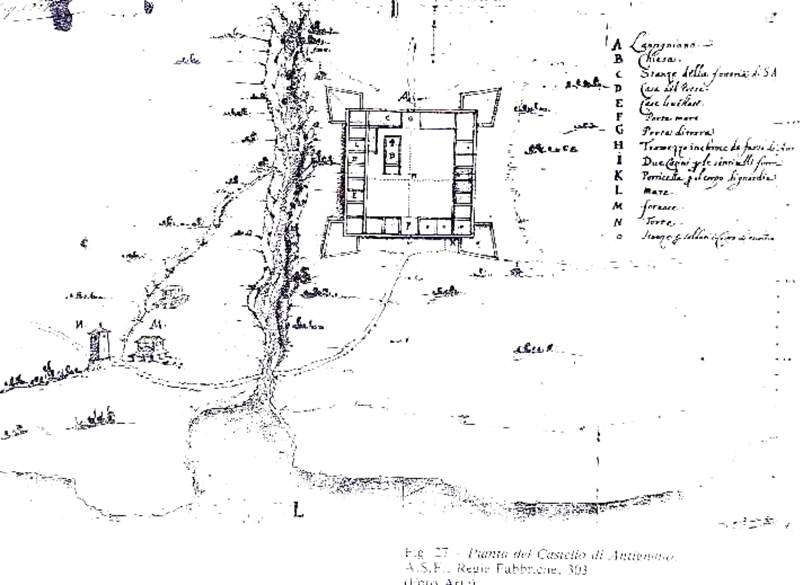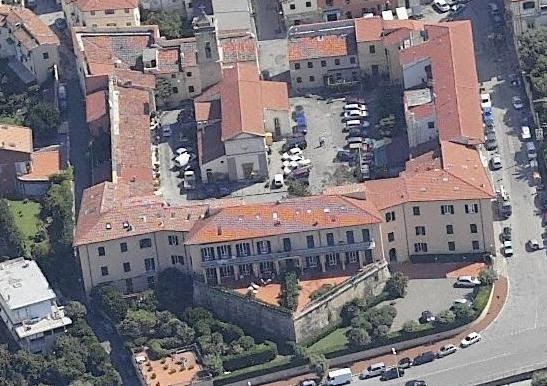L’Antignano
Si narra che:
La località L’Antignano venne, tra il 1548 ed il 1557 acquistata da Eleonora di Toledo, moglie di Cosimo I Medici Duca di Firenze, con lo scopo di trasformare quella zona boscosa e selvaggia in una ricca fattoria.
La costruzione del castello ebbe inizio nel 1560 e terminò almeno nel 1567, infatti Benvenuto Cellini racconta di aver accompagnato Cosimo a cavallo in un luogo 4 miglia a Sud di Livorno dove Egli faceva erigere una piccola fortezza. Nella notte del 21 Maggio 1562 lo storico Pera cita il fatto in cui 10 persone furono rapite dai pirati proprio nei pressi di L’Antignano e questo certo dette una accelerazione ai lavori.
L’Antignano
It is said that:
The locality of Antignano was purchased between 1548 and 1557 by Eleonora di Toledo, wife of Cosimo I Medici, Duke of Florence, with the aim of transforming that wooded and wild area into a rich farm.
The construction of the castle began in 1560 and ended at least in 1567, in fact Benvenuto Cellini tells of having accompanied Cosimo on horseback to a place 4 miles south of Livorno where he had a small fortress built. On the night of May 21, 1562, the historian Pera mentions the fact that 10 people were kidnapped by pirates right near L’Antignano and this certainly accelerated the work.
Da una pianta conservata all’archivio di stato di Firenze databile anteriormente al 1675, abbiamo una visione d’insieme della struttura. I due ingressi lato mare e lato terra, all’interno la chiesetta intitolata prima a S.S. Cosimo e Damiano e in seguito a S. Lucia, alloggiamenti per la guarnigione, per i lavoranti e le stanze dei Duchi. I quattro bastioni sporgenti sugli angoli, sono detti della Campana S-O, della Fornace N-O, della Fonte N-E e del Giardino S-E.
From a map preserved in the state archive of Florence dating back to before 1675, we have an overview of the structure. The two entrances on the sea side and on the land side, inside the church first named after S.S. Cosimo and Damiano and later to S. Lucia, quarters for the garrison, for the workers and the rooms of the Dukes. The four bastions protruding on the corners are called the S-W Bell, the N-O Furnace, the N-E Fountain and the S-E Garden.
Nelle immediate vicinanze del forte, a N-O lungo la costa, oltre il botro della Banditella c’era una torre d’avvistamento e vicino due fornaci probabilmente realizzate per produrre i materiali occorrenti alla costruzione del forte e che in seguito continuarono ad operare anche per la Fabbrica di Livorno. Nel 1631 l’Antignano, per la sua posizione isolata fu usato come luogo di quarantena per le truppe “lombarde” reduci dalla spedizione nello stato di Milano, al servizio del re di Spagna e contagiati dalla peste, furono molti i morti anche tra gli abitanti. Nel 1749, da una descrizione del colonnello Odoardo Warren, l’armamento del forte era così composto: Tre pezzi del calibro di 4 libbre, 2 da una libbra, sei spingarde, sedici moschetti a miccia e varie munizioni; mentre la guarnigione era composta da 1 Castellano (uff.), 1 caporale, 1 cannoniere e tredici soldati tra fissi e rinforzi. Nel 1878 la famiglia Cremoni acquistò la struttura trasformandola un un elegante e lussuoso albergo sul mare. Successive modifiche ne hanno completamente snaturato l’immagine, oggi l’unico riferimento rimane il “rivellino” proprio di fronte al mare. +
In the immediate vicinity of the fort, NW along the coast, beyond the Banditella cave, there was a lookout tower and near two furnaces probably built to produce the materials needed to build the fort and which later continued to operate also for the Livorno factory. In 1631 Antignano, due to its isolated position, was used as a quarantine place for the “Lombard” troops returning from the expedition to the state of Milan, in the service of the King of Spain and infected by the plague, many were also killed among the inhabitants . In 1749, from a description by Colonel Odoardo Warren, the fort’s armament was composed as follows: Three pieces of the caliber of 4 pounds, 2 of a pound, six guns, sixteen matchlock muskets and various ammunition; while the garrison was made up of 1 Castellano (official), 1 corporal, 1 gunner and thirteen soldiers between stationary and reinforcements. In 1878 the Cremoni family bought the structure transforming it into an elegant and luxurious hotel on the sea. Subsequent changes have completely distorted the image, today the only reference remains the “ravelin” right in front of the sea. +



